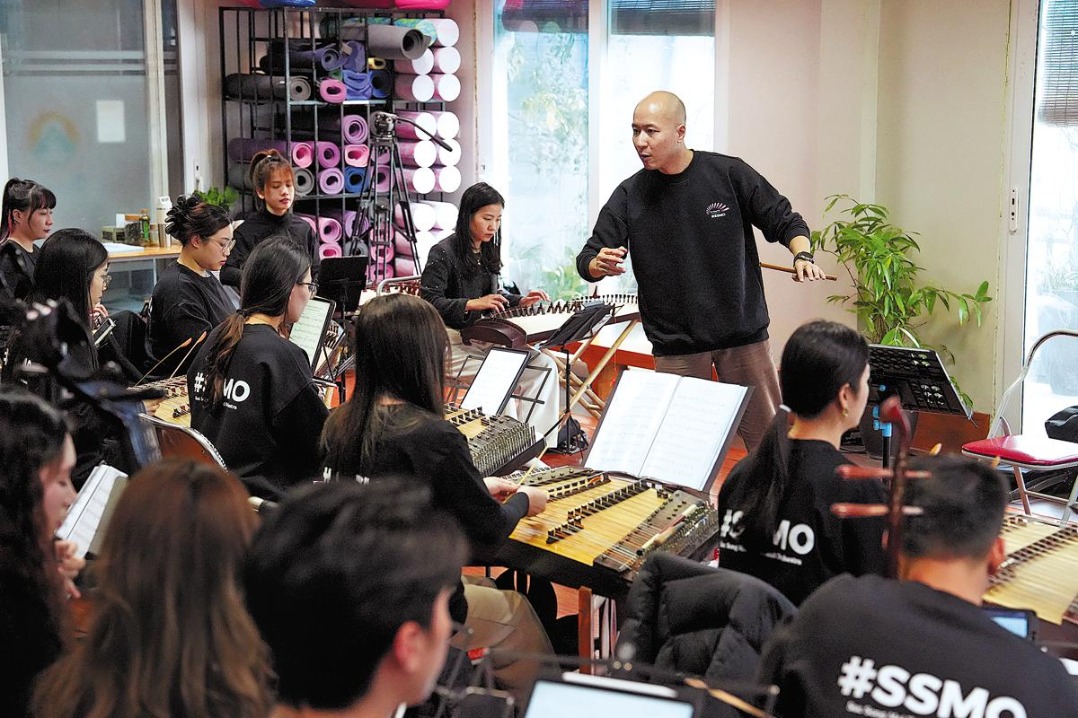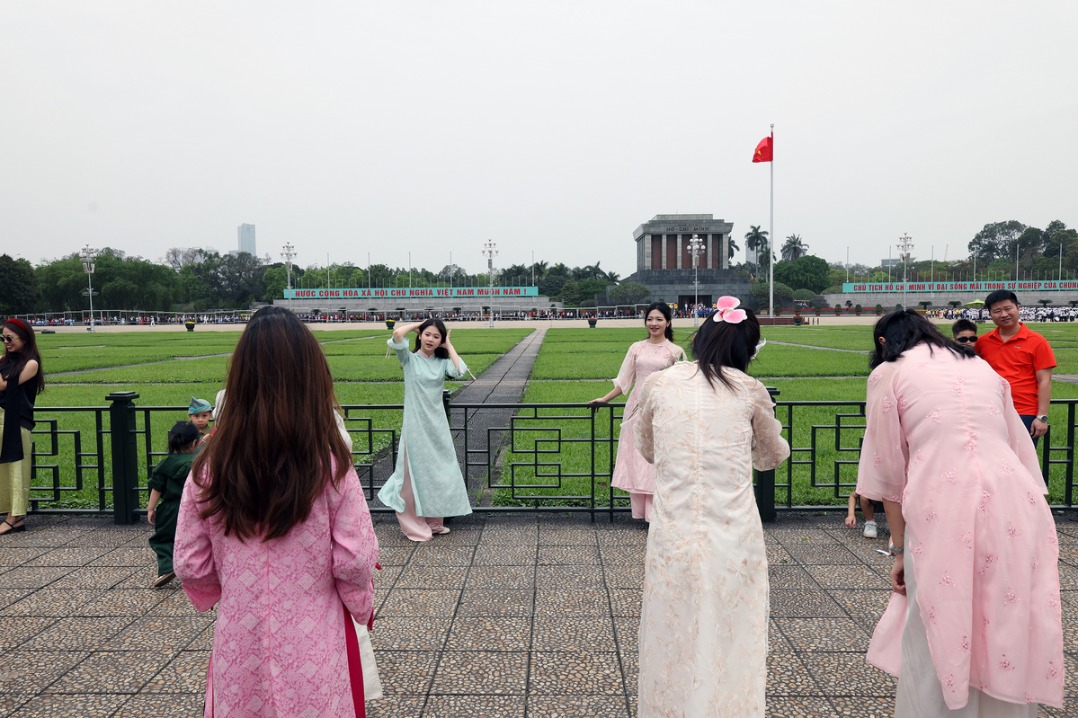Chinese companies going global: Challenges and opportunities
china.org.cn | Updated: 2025-04-15 18:22
Editor's note: An international symposium, focusing on the innovation, development and overseas expansion of Chinese companies, was held at the Tokyo Opera City Tower in Japan on Dec 1, 2024. The event was organized by Cloud River Urban Research Institute.
Key speakers included Guo Xujie, economic counselor at the Chinese Embassy in Japan; Zhou Qiren, professor at the National School of Development, Peking University; Xu Lin, chairman of the China-US Green Fund; An Ting, chairman of Beijing Chic-PIA International Cultural Development Co, Ltd; and Lin Huichun, professor at the Belt and Road School of Beijing Normal University. They shared insights on the challenges and opportunities of Chinese companies' overseas expansion.
Lin Huichun:
This discussion session revolves around two key topics. First, how can Chinese enterprises expand overseas in the face of unprecedented global changes, particularly against the backdrop of de-globalization? Second, what is the significance and role of the Belt and Road Initiative (BRI) for Chinese enterprises going global?
Guo Xujie:
Amid heightened global concerns about the world's free trade regime and economic globalization, the economic challenges faced by China will ultimately be a burden on the Chinese enterprises. In this new era, how can Chinese enterprises establish a firm foothold in the international market is a significant issue of our time.
Japanese Prime Minister Ishiba Shigeru expressed in his policy speech that he is willing to build up a track record of close communication at all possible levels between Japan and China. The two countries will gear up for a critical period seeing improvement and development of China-Japan relations.
In recent years, an increasing number of Chinese enterprises have entered the Japanese market. According to statistics from the Japan External Trade Organization, by the end of 2023, China's cumulative investment in Japan reached $8 billion, four times that of 2015. The investments span various sectors, including trade, finance, logistics, tourism, and labor, primarily concentrated in the three major metropolitan areas of Tokyo, Osaka, and Nagoya. Chinese brands such as BYD, TEMU, SHEIN, and Haier have gained a solid presence in the Japanese market, profoundly influencing and reshaping the Japanese market while establishing a positive image for China in Japan.
An Ting:
Regarding the international expansion of Chinese performing arts projects, I have several points to make.
First, solid steps should be taken to better align cultural performance projects with the international market, and help quality performances and shows reach global audiences. We must maintain confidence, make overall arrangements, and undertake time-limited planning for the international expansion of premium performances. This includes designing comprehensive strategies for project standards, support models, guarantee mechanisms, and evaluations, ensuring a targeted and goal-oriented approach.
Second, we should ensure smooth information flow and break bottlenecks. Enhancing communication is a top priority in promoting the international expansion of China's performing arts. Establishing exchange platforms, engaging key figures, and removing channel barriers are crucial. It is important to participate actively, build platforms, and focus on key aspects.
Third, proactive promotion and increased understanding come as key metrics. From a macro perspective, national-level support should be provided to create online and offline platforms for top-notch performances. From a micro perspective, promotion efforts should be integrated into the industry's international expansion. Leveraging policy funds and external resources, expanding collaborations, and drawing on expertise in program production and marketing are essential. Learning about international performing arts operations, cultivating talent, and expanding networks will help create new opportunities.
In summary, addressing thorny issues and challenges for going global is crucial. We must shift from seeking complementary advantages to integrating advantages, from individual strengths to collaboration. This will promote cultural identity, industrial collaboration, and social integration between countries and cities. This will also help to foster innovation through both "bringing in" and "going out," and build a cultural community with a shared future.
Xu Lin:
The essence of globalization is multifaceted. Despite a trend of de-globalization in the economic sphere, we must not focus solely on the economy, as globalization continues to thrive in many other areas.
First, we should encourage Chinese enterprises to access international capital markets. As Professor Zhou Muzhi mentioned earlier, going public is not just a means of financing but also a crucial way to attract international investment, enhance transparency, and raise visibility. In recent years, we have seen many overseas listed companies delist, which I personally believe is a mistake. More Chinese enterprises should be encouraged to list on foreign capital markets and more efforts should be made to increase foreign investors' understanding of Chinese businesses and allow them to share in the benefits of their growth.
Second, China's overseas financial assets have exceeded $10 trillion. How can the Chinese government protect these investments, and by what means? We should rely on international rules and agreements. We need to swiftly establish agreements and institutional frameworks with key stakeholders to safeguard China's overseas interests. Currently, we are falling short in these efforts.
Third, how can we meet the growing demand for enterprises going global? As capital flows overseas, what is the government's stance on this, and what rules should be in place? We have seen many well-known domestic enterprises face obstacles when expanding abroad, such as capital controls. These are issues the government should set out to address as more Chinese enterprises go global.
Fourth, is China's financial services sector poised to meet the needs of enterprises going global? Foreign financial institutions can provide excellent services for their enterprises abroad. However, China's financial system is not yet equipped to do this. Many Chinese enterprises abroad encounter obstacles when accessing services from foreign financial institutions, and domestic financial institutions are unable to adequately support them.
I consider the BRI more as a geographical concept. However, Western people often view it from the perspective of geopolitics. In the first place, we sought to utilize more effectively the massive amount of foreign exchange reserves we had accumulated, in order to support national development. This led to the establishment of the Asian Infrastructure Investment Bank and the New Development Bank to drive development in BRI countries, inspired by Japan's Capital Recycling Program. However, it was later misinterpreted by some people as a geopolitical strategy, which is why it is now referred to as the Belt and Road Initiative rather than the Belt and Road Strategy.
To truly make the BRI serve its purpose and the needs of Chinese enterprises going global, it should be developed into an open platform. Our current approach is still open, not closed or solely China-led, and we hope third parties can join. Additionally, the BRI must establish basic rules and institutional frameworks. Without these, there is a risk that our resource allocation under the BRI could be wasted.
Zhou Qiren:
The real world is fascinating. On one hand, there are constant conflicts between some nations, each defending their sovereignty. On the other hand, enterprises within market networks can reach overseas market beyond boundaries. Both aspects are equally real and coexist.
In 2019, during a lecture at Peking University, I mentioned that globalization based on nation-states had suffered significant setbacks, while market-driven globalization was on the rise. Now, I can say that modern market-driven globalization is essentially enterprise-driven.
The US president waged a trade war and a tech war against China, yet Tesla built a gigafactory in Shanghai. Regardless of the political relations between countries, enterprises can always engage with customers across multiple nations, even those in conflict. Today, nationalism and trade protectionism are on the rise, with national security concerns overly stressed. However, I believe the ultimate winner will be the enterprise-driven global market network, which uses its interconnectedness to counterbalance geopolitical conflicts.
Take SHEIN for example. It is the online version of ZARA. There are always consumers worldwide who enjoy refreshing their wardrobe daily without spending much. SHEIN targets such consumers, launching 50,000 new designs weekly in European and American markets via the internet. Once orders come in, they are immediately mass produced by small and medium-sized enterprises in Foshan and Panyu, Guangdong province. Their manufacturing responds swiftly to market demand, creating hit products that are then distributed globally through their network. As Professor Zhou Muzhi mentioned earlier, SHEIN's sales in Japan are approaching those of Uniqlo, even though this company is unfamiliar to many people in China.
We have students working at Amazon who say that Amazon's stock price is currently being pressured by two Chinese apps: Pinduoduo and SHEIN. The mindset of these enterprises is different from ours. What we see is clearly defined national borders, while they see a commercial network connected by supply chains, customer chains, and intermediary service providers.
























